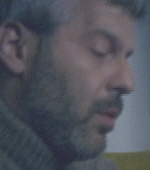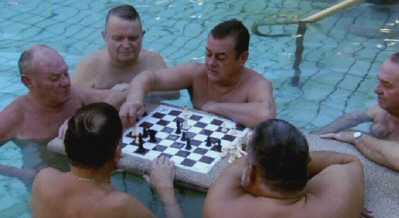Chess Grand Master

Susan Polgar lives and works in New York City. She sees the world in a very unusual way. Susan has the brain of a genius, perfectly adapted to her single, life-long obsession. Susan is the first female Chess Grand Master. But, she wasn’t born with her brilliant brain, it was created by an extraordinary childhood. Susan is the living proof of an amazing theory, that any, ordinary, child can be turned into a genius.
It’s Sunday morning and New York’s Greenwich Village is the setting for a showdown. Playing white; Susan Polgar, Playing black; Paul Truong a former US champion of a super-charged form of chess - Blitz. Each player must play the entire game in just sixty seconds. The minute is up and Paul is out of time.
By understanding Susan’s brilliant brain, we can unlock the potential of our own. We can understand how people make life-or-death decisions faster than a super-computer or perform miracles of memory in their everyday jobs.
Susan has competed, on equal terms, with the greatest names in chess, like Gary Kasparov, Anatoly Karpov and even the great Bobby Fisher. But, Susan’s genius is no accident of birth, she was once an ordinary four year old whose life was transformed by a unique education. Susan Polgar grew up a world away from New York City. In the late 1960s, Hungary still languished in the iron-grip of The Soviet Union. For the ordinary citizens of Budapest, daily life was a grim struggle to make ends meet. The future queen of the chess board was hardly born a princess.

Although Susan’s home was very humble, her father was a man with a unique vision. A trained psychologist, Laszlo Polgar, had made a deep study of the childhood origins of genius. The archetypal example was Wolfgang Amadeus Mozart. Already composing at the age of five, he seemed to be the classic case of a child born with special gifts, but Laszlo noted that Mozart’s father Leopold, himself an accomplished musician, gave his son early and invaluable schooling in his craft.
Laszlo decided that specialised training was more important than natural talent and he had an astonishing plan that would put his theory to the test.
When Zsuzsa (Susan) was born in April of 1969, the Polgar family experiment was underway. Her father had already written a book called “Bringing up Genius” and it said that genius was not born, but made. Susan translates a quote from the book: “Genius equals work and fortunate circumstances”. By fortunate circumstances, Laszlo meant the happy home that he and his wife Clara would provide and the hard work was guaranteed by schooling Susan himself.
Laszlo planned to train Susan in mathematics but, she chose her own future by a happy accident. One day while searching for a new toy, she happened across a chess set. There was no history of brilliant chess players in the Polgar family. Laszlo himself was strictly an amateur but, he was convinced he could train his daughter to be a genius at anything, as long as she was a willing student.
Easy perhaps if Susan had chosen music or science, but devoting her childhood to chess made the quest for genius much harder; for one reason. In the early 1970s, chess was totally dominated by men. Some of the world’s best players believed that the female brain just couldn’t cope with the game. A little girl was about to prove them wrong. In the early 1970s, it was taken for granted that chess required a typically male way of thinking.
Just a few months after she learned the game, Laszlo took Susan to Varos Meteor the most formidable chess club in Budapest. Susan was about to face male opposition in more ways than one. The club members thought Laszlo was mad but, if they were ready to humour a pretty little girl, they weren’t ready for what happened next. Susan began the habit of a lifetime; beating men at chess. The only man that wasn’t shocked was Laszlo Polgar, he was building Susan’s training around a mental skill that didn’t depend on eith the left or right brain. Girls could master it just as easily as boys.

Back in New York, Susan is about to play a game with a difference; playing a game of chess by ‘phone without seeing the board. Playing a game without a board helps to train the memory and Susan has been practising since childhood. She can play up to five games, in her head, simultaneously. When it comes to chess, Susan can perform miracles of memory. In fact, she’s doing something that should be impossible.
By the early 1980s, the Polgar chess factory had stepped up it’s output. Susan’s two younger sisters, Zsofia and Judit, were next on the genius assembly line and in a few years the family would be ready to take the world of chess by storm.
At fifteen, Susan was already the top-ranked female player in the world. At the 1985 New York Open, she caused a sensation by beating a grand master for the first time. By 1989, twelve year old Judit had a winning streak of eight competitions in a row and, at fourteen, Zsofia annihilated four grand masters for one of the greatest tournament results of all time.
Susan is still a powerful presence at the chess board. Like all the Polgar sisters she seems to make a move as easily as taking a breath.
CREDITS: The above information came from the UK Channel 5 “My Brilliant Brain” documentary series.
Additional Reading
[amazon template=template&title=-&artist=-&asin=1857443810] How the Polgar Sisters Changed the Game of Chess - Susan Polgar
[amazon template=template&title=-&artist=-&asin=1579125549] Chess: 5334 Problems, Combinations and Games - Laszlo Polgar
[amazon template=template&title=-&artist=-&asin=0713488905] Judit Polgar: The Princess of Chess - Tibor Karyoli
